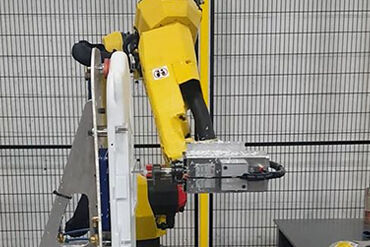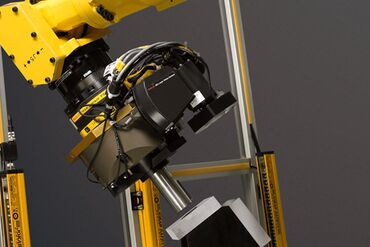Common Issues for Torch Cables
May 20, 2018
Understanding how well welding torches perform or how it’s design stacks up against others in the industry is important. Looking at common issues and best practices for torch cables will help to bring greater quality and productivity.
Understanding your welding parts will help to reduce downtime and overall wear while also increasing productivity. Robot torch parts can come in a variety of styles and build. Over time, there are some parts that have proven to be more effective and more conducive to productivity and user-friendliness than others. Being updated and knowledgeable on this information will ensure optimal production on your welding production line. This article will bring to light issues that relate to torch cables, liners, tips, and nozzles including how they fail and best practices for them.
One of the most critical components of a well-made robot torch cable is the outer jacket protecting the cable.
Outer Jackets
The durable outer jacket is a very important to help protect against abrasion, cutting, and offer increased resistance to failing if it ever catches on a clamp or fixture in the welding cell.
The outer jackets that have proven to offer incredible resistance to abrasion and cutting are irradiated with electron beams or composed with a cross-linked polyester. Even if the outer jackets are damaged, the damage won’t extend with these cable materials because the cable doesn’t have a grain running in one direction. However, the outer coating of a robot torch cable comes with trade-offs. These types of coatings are sturdy, but they are less flexible.
If there were to be a cut or abrasion on cables using neoprene, it would readily extend and increase the chances of failure for the robot torch cable. This would be one reason to make this material less desirable for a robot torch cable. However, the advantage to neoprene is that it is more flexible.
Protective Sleeves
A protective sleeve on top of the torch cable outer cover will protect the cable and cable strands from rubbing against the arm when the arm is in motion.
Cables that feature corrugated, Kevlar, or leather protective sleeves for robot torches are important to further protect the torch cable especially if your welding torch is rotating or bending.
Electrical Connections
The electrical connection of the torch cable is a critical piece in maintaining consistent and reliable power from the copper to the torch neck and ultimately to the contact tip and welding wire.
Understanding if your torch cable can stand up to the manufacturing demands also includes ensuring that the electrical components are up for the challenge. These electrical connections are seen in two common manners: a crimp of the cable at the end or a cone and a cone nut.
Crimp connection: produces a more stable and reliable electrical connection. A pad crimp will provide even pressure and a strong and consistent electrical connection and current.
Connector Cone and Cone Nut: This used to be the way to provide the electrical connection as it allowed for rotational movement and also because it could be taken apart, shortened, or modified as needed. However, people realized that this was not needed so the crimp connection was seen as more beneficial and being used with greater success.
Cable Stranding
Looking for cable stranding is one of the most important factors to help determine your cable quality. Multi-strand cables will last longer and resist torsion more than a single-strand cable.
Cables can be designed to rotate and withstand torsional loads which is a critical evaluation factor to look at when using a through-arm setup. Evaluating the need for copper or aluminum and a multi-strand or single strand are other factors to consider.

Picture Credit: The Definitive Guide to Robotic Welding Torches by Abicor Binzel
A robot torch with 5 independently stranded cables will work less to produce a strong electrical current when there’s torsion on one another and cause less friction when transferring to the outer shield. The solution would be a multistrand design and build that will last longer than a solid, or single, strand cable.
Through-arm torch cables commonly fail because of over-rotation of the cable while in operation on robot axis 4 and axis 6. The greater amount of rotation, the greater the impact on the integrity of the cable build. The strands inside the cable can break and create heat in areas of the cable it is not designed for.
If a robot torch cable is capable of rotating +/- 210 degrees consistently while in operation, then it should be considered a quality torch cable for through-arm.
Infinite or Endless Rotation torches are becoming more mainstream as there is no worry about what the cable is doing because the wrist manipulates the front end of the torch independent of the robot cable. There are necessary servo motor adjustments that are necessary to accommodate this torch technology, however it provides a greater value out of the life of their torch cable. These torches would specifically benefit operations in the oil and gas, automotive, irrigation, pipe, or agricultural industry.
Common Issues with Over-Arm Cables:
Unscheduled downtime and costly repairs can occur when welding torch cables are not properly adjusted and placed. It is important to understand the necessary length for your over-arm cables so that they can give you the most life. To achieve proper length, make sure the robot can achieve full movement without the torch cable hanging from the side.
Too long of a cable and it will get caught, experience a lot of rubbing onto tooling, and quickly wear out. Long cables can also experience excessive heat and torsional force from it moving too violently, causing failure.
Too short of a cable will limit the rotation axis 4 and axis 6 providing for access issues, incur more stress, and fail prematurely.
Besides the cable length, it is also important to look the placement and support of your wire feeding unit. This unit can be placed at specific locations or angles to help create further efficiencies with the robot torch cable. The support can help the cable maintain a stable arc instead of hanging in a way that compromises the cable’s integrity and wire feeding.
Benefits of Through-Arm Cables:
There is less margin for error on cable length with through-arm cables so choosing the correct length is the most important step. It is critical to keep the difference between the torch body and the wire feed interface to no more than 5 mm.
How Cables Fail:
- Abrasion: When a cable rubs up against the part and eventually fails. A cable abrades when the robot puts a torch cable through the same cycle over and over multiple times.
- Cutting: When the cable comes in contact with a sharp edge to a part over and over .
- Caught: If the cable isn’t installed properly, the cable can get caught on a fixture or part and halt production.
In summary, it is important to ensure your torch cable has a proper outer jacket; A protective corrugated sleeve; Has either a strong crimped or coned connection; Is a single strand or multi-strand; Is at the correct length for your robot; The cable is set-up for the proper +/- torch cable length; and The wire feeding unit is placed properly.
For more information on cables, contact Robots.com experts online or at 877−762−6881.
Related Articles
You might be also interested in:

- Featured
Latest Advancements in Material Cutting Robotics
Read about the latest technological advancements in robotic material cutting.

- Featured
Emerging 3D Vision Technologies for Industrial Robots
Learn about the emerging 3D vision technology that businesses are using for industrial robot applications.

- Featured
Most Popular Industrial Robotic Applications for 2021 and Projections
Explore the most popular application trends of 2021 and what to expect in the future.
Let's talk!
Request your quick quote today.

